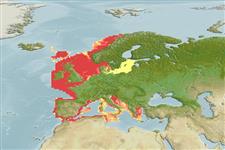Teleostei (teleosts) >
Gobiiformes (Gobies) >
Gobiidae (Gobies) > Gobionellinae
Etymology: Crystallogobius: Latin, cristallum = ice + Latin, gobius = gudgeon (Ref. 45335).
Environment: milieu / climate zone / depth range / distribution range
Ecology
Marine; demersal; non-migratory (Ref. 4696); depth range 1 - 400 m (Ref. 35388). Temperate; 70°N - 35°N, 11°W - 25°E
Eastern Atlantic: Lofotens, Norway, to Gibraltar. Also known from the Mediterranean Sea. Eastern Central Atlantic: Madeira Island (Ref. 74541).
Size / Weight / Age
Maturity: Lm ? range ? - ? cm
Max length : 4.7 cm SL male/unsexed; (Ref. 4696); 3.9 cm SL (female); max. reported age: 1.00 years (Ref. 232)
Dorsal spines (total): 2 - 3; Dorsal soft rays (total): 18 - 20; Anal spines: 1; Anal soft rays: 20 - 21. Patterns of sensory papillae require detailed description. Pronounced sexual dimorphism. Anterior nostril a short tube. Pectoral fin uppermost rays within membrane. Males: with prominent front canine teeth; pelvic disc complete and deep; 1st dorsal with only 2 with rays. Females: pelvic disc reduced or lacking; 1st dorsal absent or rudimentary. Vertebrae 30(29-31).
Benthic and free swimming (Ref. 92840). This occasionally territorial species occurs in coastal waters, over shell, sand, or mud bottoms; males bottom-living during breeding season. Feed on zooplankton (Ref. 5204). Spawning takes place when 1 year old. Adults die afterwards. Eggs are laid in the empty tube-worms and are guarded by the male (Ref. 35388). Eggs are pear-shaped (Ref. 4696).
Males guard eggs in empty tubes of larger worms, such as Chaetopterus. Adults die after breeding (Ref. 4696).
Wheeler, A., 1992. A list of the common and scientific names of fishes of the British Isles. J. Fish Biol. 41(suppl.A):1-37. (Ref. 5204)
IUCN Red List Status (Ref. 130435)
Threat to humans
Harmless
Human uses
Fisheries: of no interest
Tools
Special reports
Download XML
Internet sources
Estimates based on models
Preferred temperature (Ref.
123201): 6.8 - 14.3, mean 9.8 °C (based on 546 cells).
Phylogenetic diversity index (Ref.
82804): PD
50 = 1.0000 [Uniqueness, from 0.5 = low to 2.0 = high].
Bayesian length-weight: a=0.00724 (0.00338 - 0.01553), b=3.05 (2.87 - 3.23), in cm total length, based on LWR estimates for this (Sub)family-body shape (Ref.
93245).
Trophic level (Ref.
69278): 3.4 ±0.45 se; based on food items.
Generation time: 1.1 ( na - na) years. Estimated as median ln(3)/K based on 1
growth studies.
Resilience (Ref.
120179): Medium, minimum population doubling time 1.4 - 4.4 years (tm=1; tmax=1; Fec=340).
Fishing Vulnerability (Ref.
59153): Low vulnerability (14 of 100).
Nutrients (Ref.
124155): Calcium = 156 [75, 491] mg/100g; Iron = 0.658 [0.278, 1.486] mg/100g; Protein = 17 [15, 19] %; Omega3 = 0.567 [0.214, 1.379] g/100g; Selenium = 12.1 [4.5, 34.6] μg/100g; VitaminA = 49.2 [10.7, 235.1] μg/100g; Zinc = 1.07 [0.65, 1.76] mg/100g (wet weight);
